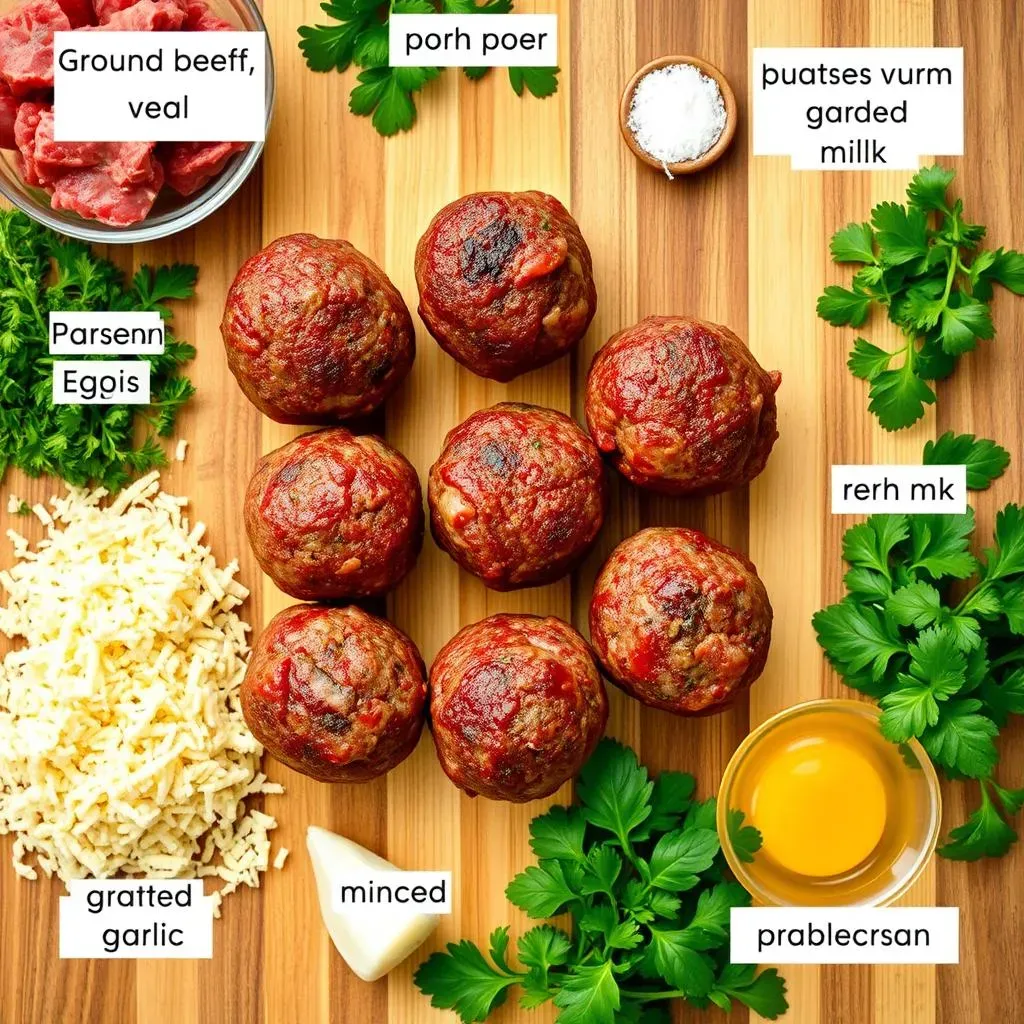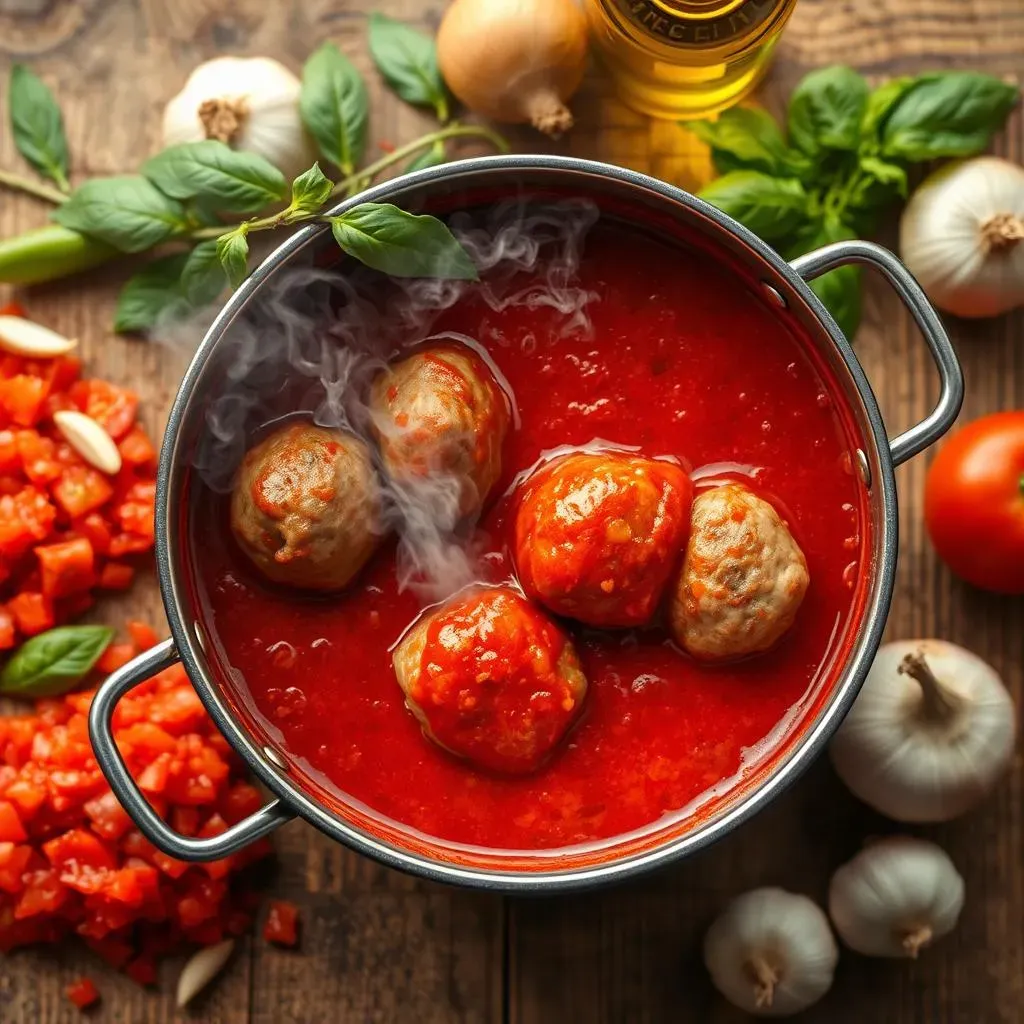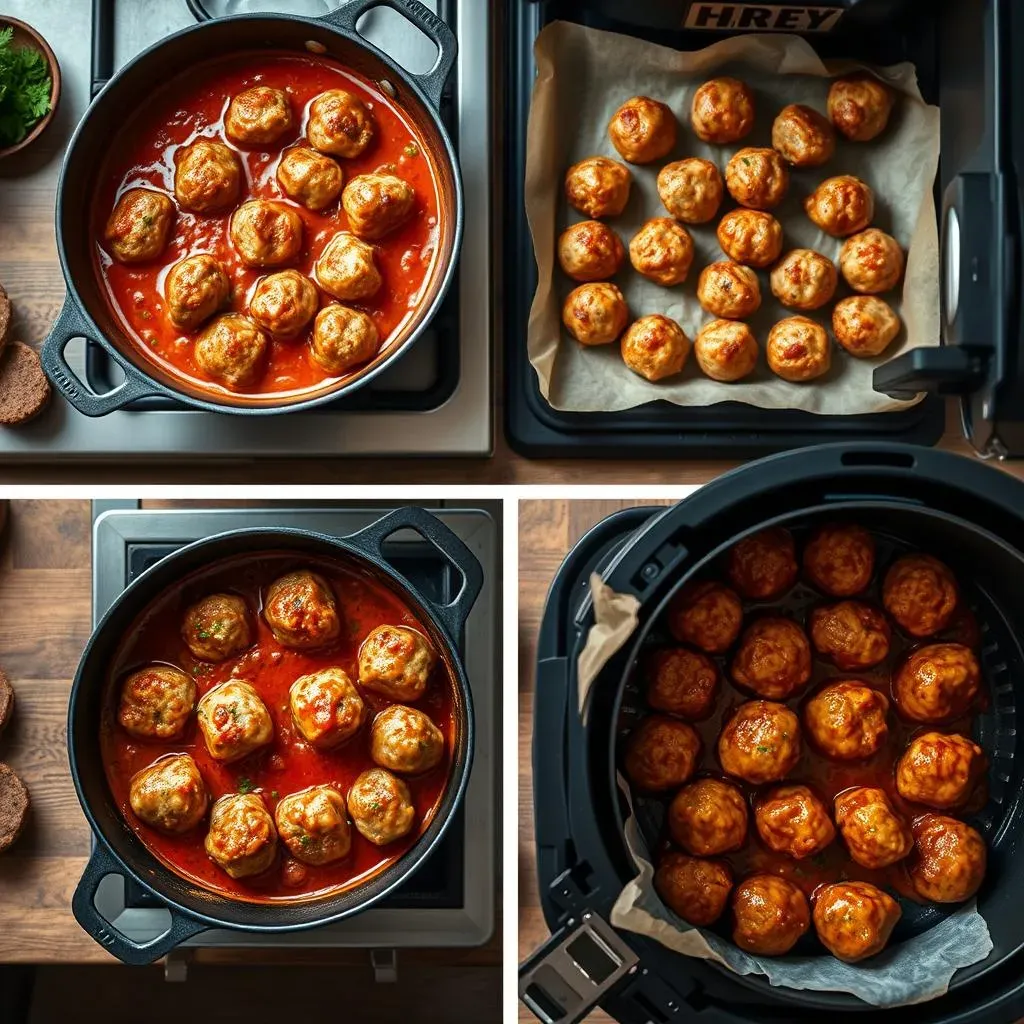Is there anything more comforting than a plate of spaghetti and meatballs, especially when every element is made from scratch? This isn't just about throwing something together; it's about creating an experience, a taste of Italy right in your own kitchen. We're diving headfirst into the heart of Italian-American cuisine with the ultimate homemade meatballs and sauce recipe. Forget the jarred stuff – we're talking rich, deeply flavorful sauce and tender, juicy meatballs that will have everyone asking for seconds (and the recipe!).
Crafting the Perfect Homemade Meatballs: Ingredients and Techniques

Crafting the Perfect Homemade Meatballs: Ingredients and Techniques
The Meat Matters: Choosing Your Blend
Let's be real, the heart of any great meatball is, well, the meat! Don't just grab any ground beef and call it a day. The best meatballs boast a blend. I'm talking ground beef, pork, and veal. The beef provides that classic meatball flavor, the pork adds moisture and a touch of sweetness, and the veal? Veal brings a tenderness that's simply unmatched. Aim for a ratio of roughly 1:1:1 for a balanced bite. If you can't find veal, don't sweat it – an extra portion of pork will do the trick. Also, don't be afraid of a little fat! Lean meat makes for dry meatballs. Opt for ground beef with around 80% lean to 20% fat.
Beyond the blend, consider the grind. A medium grind is ideal. Too fine, and your meatballs will be dense. Too coarse, and they might fall apart. If you're feeling ambitious, grind your own meat! It's a game-changer in terms of flavor and texture. But honestly, good quality ground meat from your butcher works just fine. The key is to start with the best possible ingredients. Think of it like this: you can't build a mansion on a shaky foundation, and you can't make amazing meatballs with subpar meat.
Bind, But Don't Overwork: Achieving the Right Texture
So, you've got your meat blend sorted. Now comes the crucial part: binding it all together. Forget the notion that more is better. Overworking the meat mixture is a cardinal sin when it comes to meatball making. The more you mix, the tougher your meatballs will be. Aim for a light touch. Think of it as gently coaxing the ingredients together, not wrestling them into submission.
What goes into the binder? Breadcrumbs are a must. Use fresh breadcrumbs, ideally homemade. They're lighter and absorb moisture better than the store-bought kind. Soak them in milk or cream before adding them to the meat mixture. This ensures that your meatballs stay moist and tender. Eggs are another essential binding agent, providing structure and richness. A sprinkle of grated Parmesan cheese adds a savory depth, while fresh herbs like parsley and basil brighten the flavor. Don't forget the garlic! Minced garlic is non-negotiable for that authentic Italian flavor. Gently combine everything until just incorporated. That's the secret to meatball perfection.
Ingredient | Purpose | Tips |
|---|---|---|
Ground Beef | Flavor base | 80/20 blend for moisture |
Ground Pork | Moisture and sweetness | Adds tenderness |
Ground Veal | Tenderness | Optional, but recommended |
Breadcrumbs | Binding and moisture | Soak in milk or cream |
Parmesan Cheese | Flavor | Freshly grated is best |
Simmering Success: The Ultimate Homemade Sauce Recipe for Meatballs

Simmering Success: The Ultimate Homemade Sauce Recipe for Meatballs
The Foundation: Tomatoes and Aromatics
Alright, let's talk sauce. Forget the jarred stuff; we're building a flavor bomb from the ground up. The base of any great tomato sauce is, unsurprisingly, tomatoes. Crushed tomatoes are my go-to for their texture and sweetness. San Marzano tomatoes are the gold standard, but any good quality crushed tomatoes will work. Now, for the aromatics – this is where the magic happens. Olive oil, garlic, and onions are your holy trinity. Sauté the garlic and onions in olive oil until they're soft and fragrant. Don't rush this step! It's crucial for building depth of flavor. A pinch of red pepper flakes adds a subtle kick, while a bay leaf infuses the sauce with a subtle herbal note. Don't skimp on the olive oil either! It adds richness and helps to emulsify the sauce.
Once the aromatics are ready, add the crushed tomatoes and bring the sauce to a simmer. Season generously with salt and pepper. Remember, you can always add more seasoning later, but you can't take it away! Let the sauce simmer for at least an hour, or even longer if you have the time. The longer it simmers, the more the flavors will meld together and deepen. Stir occasionally to prevent the sauce from sticking to the bottom of the pot. Taste as you go and adjust the seasoning as needed. This is your sauce, so make it your own!
Building Flavor: Herbs, Spices, and Secret Weapons
So, your sauce is simmering away, and your kitchen smells amazing. Now it's time to take it to the next level with herbs, spices, and a few secret weapons. Fresh basil and oregano are essential for that classic Italian flavor. Add them towards the end of the cooking process to preserve their freshness. A pinch of sugar helps to balance the acidity of the tomatoes, while a splash of balsamic vinegar adds a touch of sweetness and complexity. Now, for the secret weapons: a Parmesan cheese rind adds a savory depth, while a knob of butter adds richness and shine. Don't knock it 'til you try it! These little additions can make a world of difference.
If you're feeling adventurous, try adding other vegetables to your sauce. Carrots, celery, and bell peppers can add sweetness and depth. Just sauté them along with the garlic and onions at the beginning of the cooking process. Some people swear by adding a bit of tomato paste for extra richness. Others like to add a splash of red wine for complexity. The possibilities are endless! The key is to experiment and find what works best for you. Remember, cooking is all about having fun and creating something delicious.
Ingredient | Purpose | Tips |
|---|---|---|
Crushed Tomatoes | Base of the sauce | San Marzano are ideal |
Garlic & Onions | Aromatics | Sauté until soft and fragrant |
Fresh Basil & Oregano | Herbal flavor | Add towards the end |
Sugar | Balance acidity | Just a pinch! |
Parmesan Rind | Savory depth | Remove before serving |
From Stovetop to Air Fryer: Cooking Homemade Meatballs and Sauce to Perfection

From Stovetop to Air Fryer: Cooking Homemade Meatballs and Sauce to Perfection
The Classic Simmer: Low and Slow Wins the Race
so you've got your beautiful meatballs and your simmering sauce. Now, how do we bring them together in holy matrimony? The classic method is the stovetop simmer. Gently nestle the meatballs into the sauce, making sure they're mostly submerged. Bring the sauce back to a gentle simmer, then cover the pot and let it cook for at least an hour, or even longer. The longer they simmer, the more the meatballs will absorb the sauce's flavor, and the sauce will thicken and deepen in richness. Stir occasionally to prevent sticking and ensure even cooking. This method is all about patience, but trust me, the results are worth it.
One of the best parts about simmering the meatballs in the sauce is that it's a very forgiving method. If the sauce gets too thick, just add a little water or broth to thin it out. If it's too thin, remove the lid and let it simmer for longer to reduce. You can also add additional ingredients to the sauce while it's simmering, such as extra herbs, spices, or vegetables. This is a great way to customize the flavor to your liking. Just be sure to taste as you go and adjust the seasoning accordingly.
- Pros: Classic flavor, forgiving method, allows for maximum flavor absorption.
- Cons: Requires more time, needs monitoring to prevent sticking.
Baking for Ease: Hands-Off Approach
If you're looking for a more hands-off approach, baking your meatballs in the oven is a great option. Preheat your oven to 375°F (190°C). Place the meatballs on a baking sheet lined with parchment paper. Bake for about 20-25 minutes, or until they're cooked through and lightly browned. While the meatballs are baking, heat up your sauce in a separate pot on the stovetop. Once the meatballs are done, gently transfer them to the sauce and let them simmer for a few minutes to meld the flavors. Baking is a great option if you're making a large batch of meatballs, as you can cook them all at once without having to worry about overcrowding a pan.
Baking also has the advantage of being a bit healthier than frying, as you don't need to use any oil. However, it's important to make sure that your meatballs don't dry out in the oven. To prevent this, you can brush them with a little olive oil before baking, or you can place a pan of water in the bottom of the oven to create steam. Another tip is to slightly undercook the meatballs in the oven, as they will continue to cook in the sauce. This will help to ensure that they stay moist and tender.
Method | Pros | Cons |
|---|---|---|
Stovetop Simmer | Maximum flavor, forgiving | Time-consuming, needs monitoring |
Baking | Hands-off, good for large batches | Can be drying, less flavor absorption |
Air Frying | Quick, crispy exterior, healthier | Can dry out meatballs, small batches |
Air Fryer Advantage: Crispy on the Outside, Tender on the Inside
Want that perfectly browned exterior without all the oil of frying? Enter the air fryer! This method is surprisingly effective for meatballs. Preheat your air fryer to 400°F (200°C). Place the meatballs in the air fryer basket in a single layer, making sure they're not overcrowded. Cook for about 10-12 minutes, flipping halfway through, until they're golden brown and cooked through. Then, just like with the baking method, transfer the air-fried meatballs to your simmering sauce to finish cooking and absorb all that delicious flavor. The air fryer gives the meatballs a fantastic crispy texture that's hard to resist.
The key to success with the air fryer is to not overcrowd the basket. If you try to cook too many meatballs at once, they won't brown evenly. You may need to cook them in batches. Also, keep an eye on them, as air fryers can vary in cooking time. You don't want to overcook them and dry them out. A light spray of olive oil can help them brown even better, but it's not strictly necessary. Once they're done, the contrast between the crispy exterior and the tender interior is just heavenly!
Serving and Storing Your Delicious Homemade Meatballs and Sauce

Serving and Storing Your Delicious Homemade Meatballs and Sauce
Serving Suggestions: Beyond Spaghetti
so you've got this amazing homemade meatballs and sauce recipe, and the aroma is driving everyone wild. Of course, spaghetti is the classic choice, but don't limit yourself! Think beyond the noodle. Meatball subs are always a crowd-pleaser, especially with some melted provolone cheese. Or, how about meatball parmesan? Layer those beauties with sauce and mozzarella, then bake until bubbly and golden brown. Seriously, it's heaven on a plate. And for something a little different, try serving them over creamy polenta or mashed potatoes. The rich sauce just soaks right in, creating a flavor explosion with every bite. Don't forget a sprinkle of fresh parsley and a generous grating of Parmesan to finish things off!
Another fun idea is to use the meatballs in a hearty lasagna. Layer them with ricotta cheese, pasta sheets, and plenty of sauce for a truly decadent meal. Or, if you're looking for a lighter option, serve them with zucchini noodles or roasted vegetables. The possibilities are endless! The key is to get creative and experiment with different flavor combinations. And remember, presentation matters! A beautifully plated dish is always more appealing. So, take a few extra minutes to arrange your meatballs and sauce artfully on the plate. Your guests will appreciate the effort.
Serving Idea | Description | Why it Works |
|---|---|---|
Spaghetti and Meatballs | Classic Italian comfort food | Perfect pairing, always a hit |
Meatball Subs | Hearty sandwich with melted cheese | Easy to eat, great for lunch or dinner |
Meatball Parmesan | Baked with sauce and mozzarella | Rich and decadent, a crowd-pleaser |
Over Polenta/Mashed Potatoes | Creamy base for the sauce | Comforting and flavorful |
In Lasagna | Layered with pasta and cheese | Hearty and satisfying |
Storage and Reheating: Making the Most of Leftovers
Let's face it, even the most enthusiastic meatball lovers sometimes have leftovers. The good news is that homemade meatballs and sauce recipe store beautifully, making them perfect for meal prepping or a quick and easy weeknight dinner. To store, simply let the meatballs and sauce cool completely before transferring them to an airtight container. They'll keep in the refrigerator for up to 3-4 days. For longer storage, you can freeze them for up to 2-3 months. When freezing, it's best to portion them out into individual servings so you can easily thaw only what you need.
Reheating is a breeze. You can gently reheat the meatballs and sauce in a saucepan over medium heat, stirring occasionally, until heated through. Or, for a quicker option, you can microwave them. Just be sure to cover them to prevent splattering. If you're reheating frozen meatballs, it's best to thaw them in the refrigerator overnight before reheating. This will help to prevent them from drying out. And there you have it! Delicious homemade meatballs and sauce, ready to enjoy whenever you crave them. Enjoy!
- Refrigerating: Store in an airtight container for 3-4 days.
- Freezing: Portion into individual servings, freeze for 2-3 months.
- Reheating: Simmer on stovetop or microwave, thaw frozen meatballs first.
Savoring the Simplicity: Your Homemade Meatballs and Sauce Recipe Awaits
There you have it – a complete guide to crafting the most delicious homemade meatballs and sauce recipe, one that's sure to become a family favorite. From selecting the right ingredients to mastering the cooking techniques, you're now equipped to bring a taste of Italy to your own table. Don't be afraid to experiment with variations and make it your own. The joy of cooking lies in the process, and the reward is a meal that nourishes both body and soul. So, gather your ingredients, roll up your sleeves, and get ready to create a culinary masterpiece. Buon appetito!